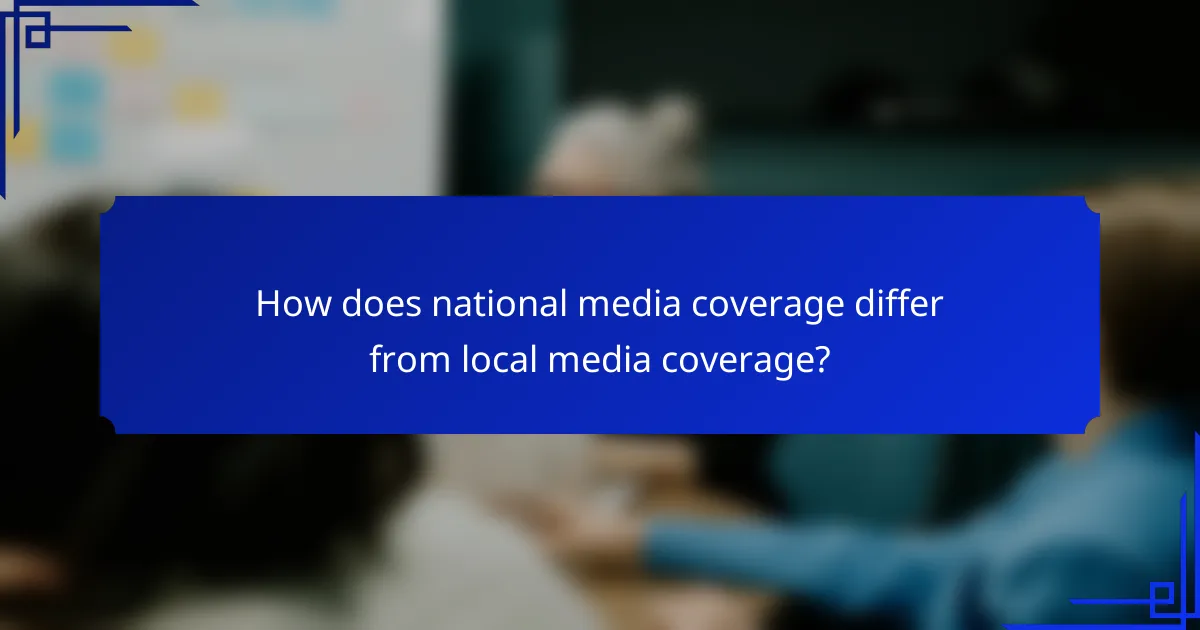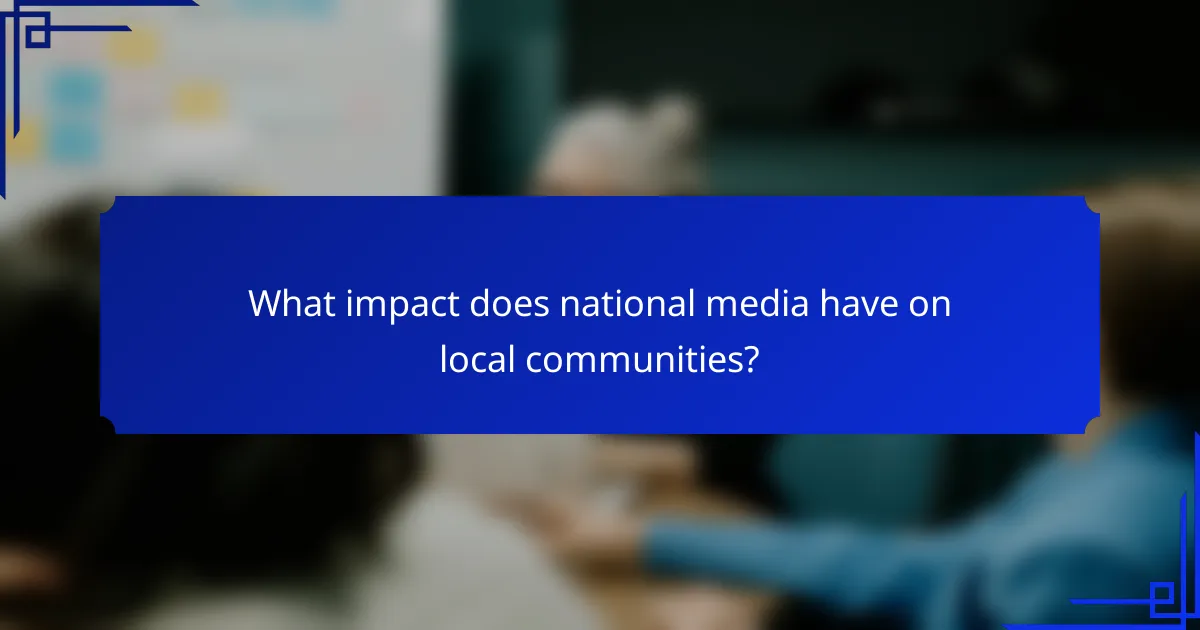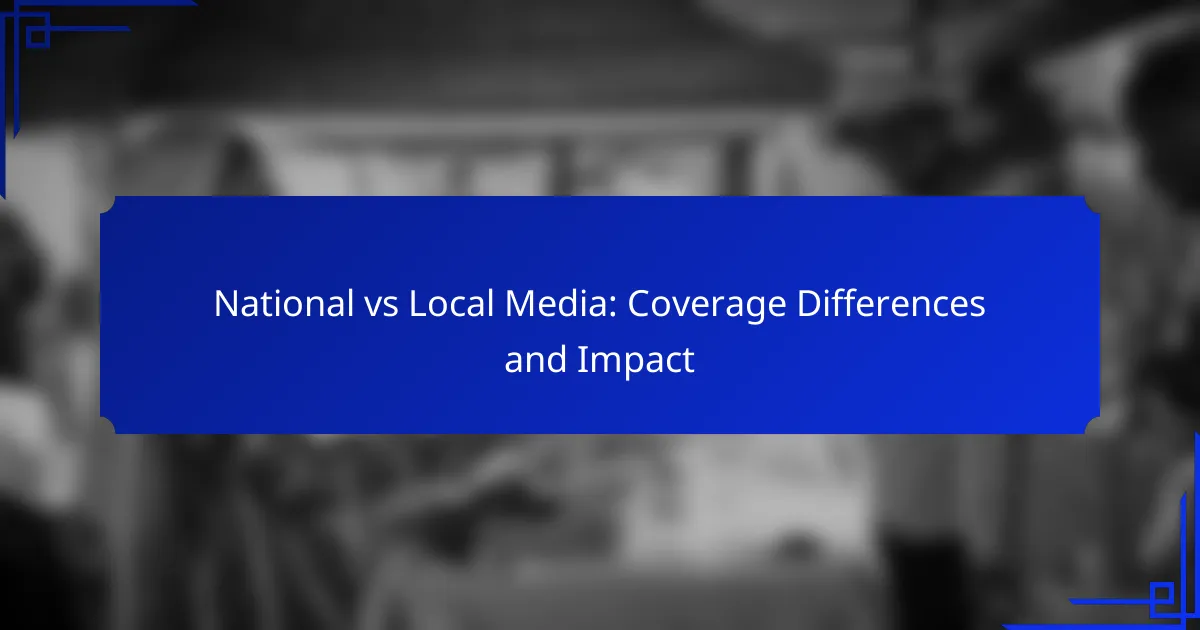The distinction between national and local media coverage plays a crucial role in shaping public perception and community engagement. While national media addresses broader issues impacting the entire country, local media focuses on community-specific news, fostering a deeper connection with its audience. This difference not only influences how stories are reported but also affects the resources allocated to each type of coverage, ultimately impacting local priorities and responses.

How does national media coverage differ from local media coverage?
National media coverage typically focuses on broader issues that affect the entire country, while local media coverage emphasizes community-specific news and events. This distinction shapes how stories are reported, the audiences they target, and the resources allocated to each type of coverage.
Scope of coverage
National media often covers significant events, policies, and trends that have implications across the country, such as federal legislation or national elections. In contrast, local media focuses on community events, local government actions, and issues directly affecting residents, such as school board meetings or local crime reports.
This difference in scope means that national stories may overlook local nuances, while local stories may not receive attention from national outlets, leading to a gap in information for audiences seeking comprehensive coverage.
Target audience
The target audience for national media includes a diverse group of individuals from various regions, often with interests in politics, economy, and culture at a macro level. Local media, however, caters specifically to the residents of a particular area, focusing on issues that resonate with their daily lives.
This targeted approach allows local media to build stronger community ties and foster engagement, while national media aims to inform a broader audience, often sacrificing localized context for wider relevance.
Content focus
National media content typically emphasizes high-level analysis, expert opinions, and major developments that shape public discourse. Local media, on the other hand, often highlights human-interest stories, local achievements, and grassroots movements that may not be covered by national outlets.
This focus on content allows local media to create a sense of community and connection, while national media provides a platform for understanding larger societal trends.
Reporting style
National media often employs a formal reporting style, utilizing in-depth analysis, expert commentary, and a focus on data-driven storytelling. Local media tends to adopt a more conversational tone, often incorporating community voices and personal anecdotes to engage readers.
This difference in style can influence how stories are perceived; national media may be viewed as authoritative, while local media is often seen as relatable and accessible.
Resource availability
National media organizations typically have more resources, including larger budgets, extensive networks of correspondents, and access to advanced technology for reporting. This enables them to cover a wider range of topics and conduct thorough investigations.
Local media, while often operating with limited resources, can still provide valuable insights through community connections and localized knowledge. However, this can lead to challenges in covering larger stories that require more extensive resources.

What impact does national media have on local communities?
National media can significantly influence local communities by shaping perceptions, driving conversations, and affecting local policies. Their coverage often highlights issues that may not receive attention from local outlets, thereby impacting community priorities and responses.
Influence on public opinion
National media plays a crucial role in shaping public opinion within local communities. When a national story gains traction, it can sway local attitudes and beliefs, often leading to shifts in community sentiment on various issues. For example, coverage of national protests or movements can inspire similar actions in local areas.
Moreover, the framing of news stories by national outlets can create a narrative that resonates with local audiences, reinforcing or challenging existing views. This influence can be particularly strong during elections or major events, where national narratives dominate the discourse.
Shaping local narratives
National media can shape local narratives by introducing broader contexts that influence how local issues are perceived. When national stories are reported, they often provide a lens through which local events are interpreted, which can either amplify or diminish their significance. For instance, a local economic downturn may be viewed differently if it is framed within a national recession context.
This external framing can lead to a homogenization of local stories, where unique community aspects are overshadowed by national trends. Local media may feel pressured to align their coverage with national narratives, potentially losing the distinctiveness of local issues.
Resource allocation
The impact of national media on resource allocation in local communities can be profound. When national issues receive extensive coverage, local governments and organizations may redirect resources to address these highlighted concerns, sometimes at the expense of other local needs. For example, increased media focus on homelessness at a national level can lead to more funding and initiatives in local areas.
However, this can create disparities in resource distribution, where issues that gain national attention receive more support, while less-publicized local challenges remain underfunded. Communities should be aware of this dynamic and advocate for balanced resource allocation that considers all local needs, not just those amplified by national media.

What are the advantages of local media over national media?
Local media offers several advantages over national media, primarily in terms of community connection, relevance of content, and accessibility to local issues. These factors enable local outlets to provide tailored coverage that resonates more deeply with their audiences.
Community engagement
Local media fosters strong community engagement by focusing on stories that matter to residents. This connection encourages audience participation through feedback, discussions, and local events, creating a sense of ownership among community members.
For instance, local newspapers often host town hall meetings or community forums, allowing residents to voice their concerns and influence coverage. This direct interaction builds trust and loyalty between the media and the community.
Localized content
Localized content is a hallmark of local media, as it prioritizes issues, events, and stories that are specific to the area. This can include local politics, school events, and cultural happenings that national outlets may overlook.
For example, a local news station might cover a city council meeting or a high school sports event, providing insights and details that are relevant to the community. This focus on local narratives helps residents feel more connected to their surroundings.
Accessibility for local issues
Local media excels in making information about local issues accessible to residents. It highlights topics such as public safety, local government initiatives, and community resources, ensuring that citizens are informed about matters affecting their daily lives.
Additionally, local outlets often simplify complex issues into digestible formats, such as infographics or community bulletins. This approach helps residents understand and engage with important topics, ultimately promoting civic participation.

How can businesses leverage local media for marketing?
Businesses can effectively leverage local media for marketing by utilizing its targeted reach, community engagement, and cost-effective advertising options. Local media outlets often have a loyal audience base, making them ideal for businesses looking to connect with their community.
Targeted advertising
Targeted advertising through local media allows businesses to reach specific demographics within their community. This can include ads in local newspapers, radio stations, or community websites that cater to particular age groups, interests, or geographic areas. For example, a local restaurant might advertise in a neighborhood newsletter to attract nearby residents.
When planning targeted ads, consider the timing and placement to maximize visibility. Ads placed during peak local events or in publications with high readership can yield better results. Budgeting for local ad placements typically ranges from a few hundred to several thousand dollars, depending on the medium and frequency.
Partnership opportunities
Forming partnerships with local media can enhance visibility and credibility for businesses. Collaborating on content, such as sponsored articles or interviews, can provide valuable exposure while establishing the business as a community leader. For instance, a local gym might partner with a health-focused radio show to discuss fitness tips and promote special offers.
When seeking partnerships, identify media outlets that align with your brand values and target audience. Approach them with clear proposals that outline mutual benefits, such as increased audience engagement or shared promotional efforts.
Event sponsorship
Sponsoring local events is an effective way for businesses to gain visibility and connect with their community. Events such as fairs, festivals, or charity runs often seek sponsors to help cover costs, and in return, sponsors receive advertising opportunities and brand recognition. For example, a local bank might sponsor a community festival and have its logo featured prominently on event materials.
When considering event sponsorship, assess the audience demographics and potential reach. Sponsorship costs can vary widely based on the event size and location, ranging from a few hundred to several thousand dollars. Ensure that the event aligns with your brand to maximize the impact of your sponsorship.

What criteria should businesses consider when choosing between national and local media?
Businesses should evaluate their target audience, budget, and campaign objectives when deciding between national and local media. Each type of media offers distinct advantages and challenges that can significantly impact the effectiveness of marketing efforts.
Target audience demographics
Understanding the demographics of your target audience is crucial when choosing between national and local media. National media often reaches a broader audience, which may be beneficial for brands aiming for widespread recognition. In contrast, local media allows for more targeted outreach, focusing on specific communities or regions.
For example, a restaurant may find local media more effective for attracting nearby customers, while a national brand launching a new product might benefit from the extensive reach of national outlets. Analyze your audience’s location, interests, and behaviors to make an informed choice.
Budget constraints
Budget plays a significant role in determining whether to invest in national or local media. National campaigns typically require larger budgets due to higher advertising costs and production expenses. Local media, on the other hand, often offers more affordable options, making it accessible for small to medium-sized businesses.
Consider allocating your budget based on the potential return on investment. If your goal is to build brand awareness on a national scale, a larger budget may be justified. However, if you aim to drive immediate sales in a specific area, local media could provide a better cost-to-benefit ratio.
Campaign objectives
Your campaign objectives should guide your choice between national and local media. If your goal is to establish a national presence or launch a product across multiple states, national media is likely the better option. Conversely, if you aim to engage with a local audience or promote a community event, local media will be more effective.
Define clear objectives for your campaign, such as increasing brand awareness, driving foot traffic, or generating leads. This clarity will help you determine which media type aligns best with your goals and ensure that your marketing efforts yield the desired results.

What are the emerging trends in media coverage?
Emerging trends in media coverage reflect a shift towards more localized reporting and the integration of digital platforms. National media often focus on broader narratives, while local outlets prioritize community-specific issues, leading to distinct impacts on audience engagement and information dissemination.
Increased focus on local issues
Local media are increasingly prioritizing coverage of community-specific events, concerns, and stories that resonate with their audiences. This trend allows for deeper engagement with local populations, as residents often feel more connected to issues that directly affect their daily lives.
For example, local news outlets may cover city council meetings, school board decisions, or neighborhood events, which national media might overlook. This localized focus helps foster a sense of community and encourages civic participation.
Integration of digital and social media
The rise of digital and social media platforms has transformed how news is consumed and shared. Local media are leveraging these platforms to reach wider audiences, often providing real-time updates and interactive content that engages users more effectively than traditional formats.
For instance, local news stations may use social media to broadcast live events or share breaking news, allowing for immediate audience interaction. This integration not only enhances visibility but also encourages community feedback and participation in the news process.
Shift towards audience-driven content
Media outlets are increasingly tailoring their content based on audience preferences and feedback. This trend is particularly strong in local journalism, where understanding community interests can drive coverage decisions and story selection.
Local news organizations might conduct surveys or engage with their audience through social media to identify topics of interest. This audience-driven approach helps ensure that the coverage remains relevant and impactful, ultimately fostering a stronger connection between the media and the community.
